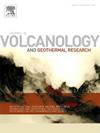Cyclical dome formation and destruction leading to highly explosive PDCs at the Late Pleistocene Tlaloc volcano, Mexico
IF 2.3
3区 地球科学
Q2 GEOSCIENCES, MULTIDISCIPLINARY
Journal of Volcanology and Geothermal Research
Pub Date : 2025-03-28
DOI:10.1016/j.jvolgeores.2025.108326
引用次数: 0
Abstract
The age, eruptive dynamics, and magmatic processes driving the explosive eruptions of the Tlaloc stratovolcano remain poorly understood. These eruptions may reflect a cyclical phase of dome growth and destruction, as suggested by lithic content variations within the Late Pleistocene units of Tlaloc. In this study, we present stratigraphic, petrological, and compositional analyses of three major units: Xichimanla (unknown age), La Joya (between 38 and 43.5 ka), and Tlaminca (∼34 ka). These units, consisting of pyroclastic density current (PDC) deposits emplaced along the NW gullies of the volcano, capture a significant part of its explosive eruptive history during the Late Pleistocene. The Xichimanla, La Joya, and Tlaminca units represent vent-opening events initiated by dome explosions, followed by boil-over-type eruptions. A distinct compositional transition from rhyodacite to rhyolite (64.16–69.25 wt% SiO2) is evident in the units. Textural and geochemical evidence, including banded pumice, disequilibrium textures in plagioclase, amphibole, and pyroxene, as well as the presence of xenoliths, xenocrystals and mineral relics, suggest that the explosive eruptions at Tlaloc were driven by magma mixing and crustal assimilation. The interaction between a mafic recharge magma and a resident felsic reservoir generated a hybridized melt, incorporating remobilized crystal mush parts from felsic reservoirs. These processes, along with volatile input from crustal assimilation, contributed to overpressure buildup and ultimately triggered explosive activity. Amphibole thermobarometry (100–500 MPa) from the La Joya PDC points to the presence of multiple magma reservoirs beneath Tlaloc, potentially explaining the compositional and textural variability. Moreover, the shift from effusive to explosive behavior may have been triggered by the intrusion of fresh, hot magmas into deeper reservoirs, introducing volatiles and heat that facilitated melt migration toward shallower chambers before eruption. These processes could explain the explosive eruptive dynamics of other stratovolcanoes in the Sierra Nevada of Mexico.
墨西哥晚更新世Tlaloc火山的周期性圆顶形成和破坏导致高度爆炸性的PDCs
时代,喷发动力学和岩浆过程驱动的特拉洛克层状火山的爆炸性喷发仍然知之甚少。这些喷发可能反映了圆顶生长和破坏的周期性阶段,正如在晚更新世的特拉洛克单元内的岩石含量变化所表明的那样。在这项研究中,我们对三个主要单元进行了地层、岩石学和成分分析:Xichimanla(未知年龄)、La Joya (38 - 43.5 ka之间)和Tlaminca (~ 34 ka)。这些单元由火山碎屑密度流(PDC)沉积物组成,分布在火山的西北沟壑上,记录了晚更新世火山爆发历史的重要部分。Xichimanla, La Joya和Tlaminca单位代表由圆顶爆炸引发的喷口打开事件,随后是沸腾型喷发。从流纹石到流纹岩(SiO2含量为64.16 ~ 69.25 wt%)的明显成分转变。条带浮石、斜长石、角闪石和辉石中的不平衡结构,以及捕虏体、异晶和矿物遗迹的存在,都表明特拉洛克的爆炸喷发是岩浆混合和地壳同化作用的结果。基性补给岩浆与长英质储层之间的相互作用产生了混合熔体,其中包含了长英质储层中再活化的晶体糊状部分。这些过程,加上地壳同化产生的挥发性输入,导致了超压的积累,最终引发了爆炸活动。来自La Joya PDC的角闪孔热气压测量(100-500 MPa)表明,在Tlaloc下方存在多个岩浆储层,这可能解释了其成分和结构的变化。此外,从喷涌到爆发的转变可能是由新鲜的、热的岩浆侵入更深的储层所引发的,这些岩浆在喷发前引入了挥发物和热量,促进了熔体向较浅的储层迁移。这些过程可以解释墨西哥内华达山脉其他平流层火山的爆炸性喷发动力学。
本文章由计算机程序翻译,如有差异,请以英文原文为准。
求助全文
约1分钟内获得全文
求助全文
来源期刊
CiteScore
5.90
自引率
13.80%
发文量
183
审稿时长
19.7 weeks
期刊介绍:
An international research journal with focus on volcanic and geothermal processes and their impact on the environment and society.
Submission of papers covering the following aspects of volcanology and geothermal research are encouraged:
(1) Geological aspects of volcanic systems: volcano stratigraphy, structure and tectonic influence; eruptive history; evolution of volcanic landforms; eruption style and progress; dispersal patterns of lava and ash; analysis of real-time eruption observations.
(2) Geochemical and petrological aspects of volcanic rocks: magma genesis and evolution; crystallization; volatile compositions, solubility, and degassing; volcanic petrography and textural analysis.
(3) Hydrology, geochemistry and measurement of volcanic and hydrothermal fluids: volcanic gas emissions; fumaroles and springs; crater lakes; hydrothermal mineralization.
(4) Geophysical aspects of volcanic systems: physical properties of volcanic rocks and magmas; heat flow studies; volcano seismology, geodesy and remote sensing.
(5) Computational modeling and experimental simulation of magmatic and hydrothermal processes: eruption dynamics; magma transport and storage; plume dynamics and ash dispersal; lava flow dynamics; hydrothermal fluid flow; thermodynamics of aqueous fluids and melts.
(6) Volcano hazard and risk research: hazard zonation methodology, development of forecasting tools; assessment techniques for vulnerability and impact.

 求助内容:
求助内容: 应助结果提醒方式:
应助结果提醒方式:


